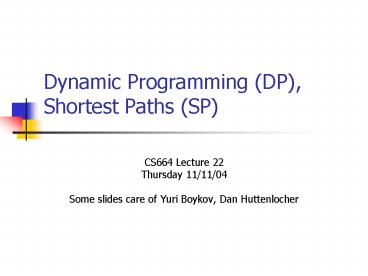Dynamic Programming (DP), Shortest Paths (SP) PowerPoint PPT Presentation
Title: Dynamic Programming (DP), Shortest Paths (SP)
1
Dynamic Programming (DP),Shortest Paths (SP)
- CS664 Lecture 22
- Thursday 11/11/04
- Some slides care of Yuri Boykov, Dan Huttenlocher
2
Level sets
Donald Tanguay
3
Level sets and curve evolution
4
Shortest path problem
Lecture theme
5
Dijkstra algorithm
6
Shortest paths segmentation
7
Shortest paths segmentation
Example find the shortest closed contour in a
given domain of a graph
Repeat for all points on the black line. Then
choose the optimal contour.
8
DP (SP) for stereo
9
Discrete snakes
- Represent the snake as a set of points
- Curve as spline, e.g. (particle method)
- Local update problem can be solved exactly
(compute global min) - Do this repeatedly
- Problems with collisions, change of topology
10
Discrete snake energy
Best location of the last vertex vn depends only
the location of vn-1
11
Discrete snakes example
control points
Fold data term into smoothness term
12
Energy minimization by SP
sites
states
1
2
m
13
Distance transform (DT)
Note can be generalized beyond 1P (DT of
arbitrary f)
14
Computing distance transforms
- Depends on the distance measure (L1 or L2
distance) - Linear time algorithms based on dynamic
programming - Fast in practice
- Can think of this as smoothing in feature space
15
Distance transform applications
- Primarily used in recognition
- Represent the model as a set of points
- Edges, or maybe corners
- Compare model to image
- Under some transformation of the model
- Chamfer matching L1 distance on distance
transform - Not robust at all
16
Hausdorff distance
- Defined between two sets of points
- h(A,B)? if every point in A lies within ? of the
nearest point in B - ? is the smallest value for which this holds
PowerShow.com is a leading presentation sharing website. It has millions of presentations already uploaded and available with 1,000s more being uploaded by its users every day. Whatever your area of interest, here you’ll be able to find and view presentations you’ll love and possibly download. And, best of all, it is completely free and easy to use.
You might even have a presentation you’d like to share with others. If so, just upload it to PowerShow.com. We’ll convert it to an HTML5 slideshow that includes all the media types you’ve already added: audio, video, music, pictures, animations and transition effects. Then you can share it with your target audience as well as PowerShow.com’s millions of monthly visitors. And, again, it’s all free.
About the Developers
PowerShow.com is brought to you by CrystalGraphics, the award-winning developer and market-leading publisher of rich-media enhancement products for presentations. Our product offerings include millions of PowerPoint templates, diagrams, animated 3D characters and more.

